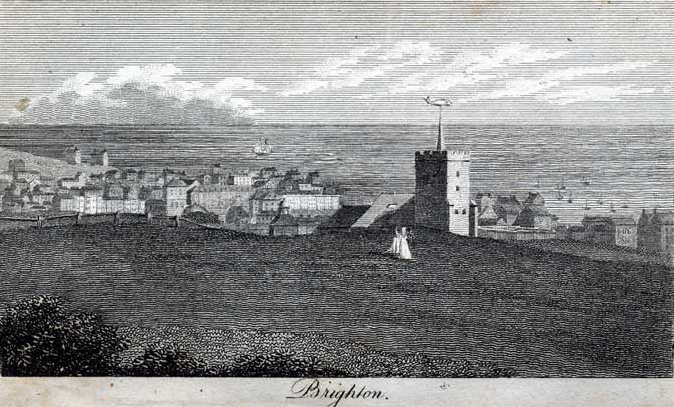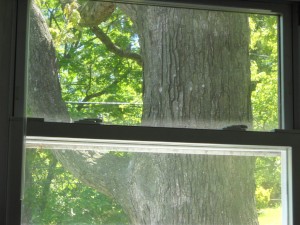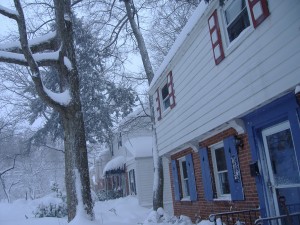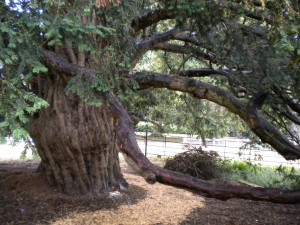As I’ve probably talked about here before, I am obsessed with Pinterest! I keep boards of inspirations for stories I’m working on (Elizabethan stuff for the new mysteries; Regency houses and gowns; random stuff for future story ideas–it works much better than folders on my computer, I can see all the goodies all together and find new ones!). I also keep boards about clothes and shoes I love, Kate Middleton stuff–I do love her, interior decorating, random things that strike me as funny, and stuff that is pink (for when I’m feeling down–somehow pink things make me feel better…). I am a very visual person and have a limited amount of attention/time, so I enjoy it more than, say, Twitter, which seems to require more attention. (Though Pinterest has led to me buying a shameful amount of Eiffel Tower objects, as well as striped skirts and mint-green bikinis)
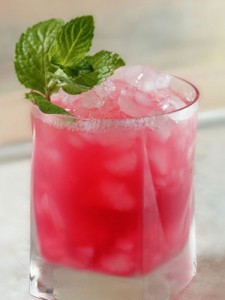 The funny thing is that my board that has the most followers, and has the most repins and likes, is my Cocktails board. I confess I do love a good cocktail–the prettier the better. My most popular pin last week was something called a Petite In Pink, which sounded to me like the perfect summer drink. It’s so simple, just champagne, cranberry, and lemon, lots of ice, perfect for sitting by the pool.
The funny thing is that my board that has the most followers, and has the most repins and likes, is my Cocktails board. I confess I do love a good cocktail–the prettier the better. My most popular pin last week was something called a Petite In Pink, which sounded to me like the perfect summer drink. It’s so simple, just champagne, cranberry, and lemon, lots of ice, perfect for sitting by the pool.
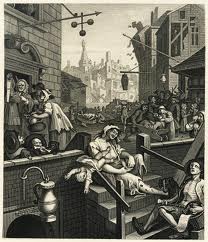 It made me wonder: what would people in the Regency want when they craved a “cocktail”?? (According to the May 13, 1806, edition of The Balance and Columbian Repository, a publication in New York, “Cock-tail is a stimulating liquor, composed of spirits of any kind, sugar, water, and bitters—it is vulgarly called bittered sling, and is supposed to be an excellent electioneering potion, inasmuch as it renders the heart stout and bold, at the same time that it fuddles the head. It is said, also to be of great use to a democratic candidate: because a person, having swallowed a glass of it, is ready to swallow any thing else.” All I can say is–Word)
It made me wonder: what would people in the Regency want when they craved a “cocktail”?? (According to the May 13, 1806, edition of The Balance and Columbian Repository, a publication in New York, “Cock-tail is a stimulating liquor, composed of spirits of any kind, sugar, water, and bitters—it is vulgarly called bittered sling, and is supposed to be an excellent electioneering potion, inasmuch as it renders the heart stout and bold, at the same time that it fuddles the head. It is said, also to be of great use to a democratic candidate: because a person, having swallowed a glass of it, is ready to swallow any thing else.” All I can say is–Word)
When I did a little research into exactly how much our historical forbears drank, well, I was impressed they could get anything done at all.
I had a vague idea that Thomas Jefferson liked a mint julep, so I went looking for 18th century recipes. I found this: The first time a Mint Julep appeared in print was in a book published in London in 1803 where the drink was described as “a dram of spirituous liquor that has mint steeped in it, taken by Virginians of a morning.” So what would a good mint julep recipe be?? And is it really good in the morning? (also the Kentucky Derby is coming up soon! Great excuse for a mint julep party):
A typical Southern recipe:
Ingredients: About 20 mint leaves; 2 tsp sugar; 2 to 3 oz. bourbon; plenty of crushed ice.
Instructions: Put mint leaves and sugar in a pewter Mint Julep cup. Muddle leaves and sugar until sugar dissolves. Add bourbon and stir. Fill a pewter cup with crushed ice and stir until an icy frost develops on the outside of the cup. Garnish with additional mint leaves or a whole sprig and serve immediately. Makes one Mint Julep Cocktail.
In the Regency, everyone was into punches (or “shrubs”). It seems like they gathered around punch bowls like modern people gather around the proverbial water cooler, to trade gossip and news (though I can’t help imagining it was more fun). Punches (or “shrubs”) were the cocktails of the day. They could involve up to 15 ingredients, including fruit juices, spices, wine, and various liquors. I can’t help but imagine what would happen if a Miss in her first Season got hold of a big glass if punch. So…what was a good punch recipe?
For a Victorian-era punch (from David Wondrich’s Punch: The Delights (and Dangers) of the Flowing Bowl:
In a mortar or small bowl, muddle a piece of ambergris the size of a grain of barley with an ounce of Indonesian gula jawa or other dark, funky sugar until it has been incorporated. Add 2 ounces Batavia arrack and muddle again until sugar has dissolved. Break up 5 ounces of gula jawa, put it in a two-quart jug with 6 ounces lime juice and muddle together until sugar has dissolved. Add the ambergris-sugar-arrack mixture and stir. Add the remains of the 750-milliliter bottle of Batavia arrack from which you have removed the 2 ounces to mix with the ambergris, stir again, and fi nish with 3 to 4 cups water, according to taste. Grate nutmeg over the top.
Let me know if you have any luck with that one.
From The Cook and Confectioner’s Dictionary (1823):
To make Punch-Royal.
Take three Pints of the best Brandy, as much Spring-water, a Pint or better of the best Lime-juice, a Pound of double refin’d Sugar. This Punch is better than weaker Punch, for it does not so easily affect the Head, by reason of the large Quantity of Lime-juice more than common, and it is more grateful and comfortable to the Stomach.
Punch for Chamber-maids.
Take a Quart of Water, a quarter of a Pint of Lime-juice; squeeze in also the Juice of a Sevil Orange and a Lemon; put in six Ounces of fine Sugar; strain all through a Strainer, three times till it is very clear; then put in a Pint of Brandy, and half a Pint of White-wine.
Which would you rather have? Punch Royal or Punch for chambermaids??
I had so much fun looking at historical drink recipes. I think they must have had a better head for liquor than us 21st cenury-ers have!!!
What is your favorite cocktail??? If you were (or have) tried a historical drink what would it be? Are you on Pinterest? What do you think of it? (I really want to know! I am new to it, but love it and am trying to figure out how to use it…)
(Also, if you are anywhere near me, I am having a Great Gatsby party next month, complete with Gin Fizzes, jazz, and flapper dresses!! It is one of my favorite books and I feel the need to celebrate the movie release, good or bad. If you want an invite, let me know…)
(And if you want to see my random obsessions on Pinterest, find me at AmandaMcCabe)
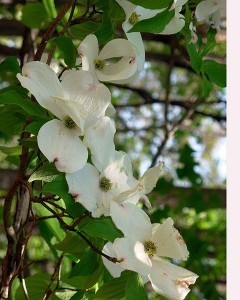 Janet’s and Myretta’s blogs and spring itself has me thinking about gardens. Spring in Virginia is at its most beautiful right now with the azaleas and dogwoods in bloom, the grass and trees a lush green and spring flowers popping up all over.
Janet’s and Myretta’s blogs and spring itself has me thinking about gardens. Spring in Virginia is at its most beautiful right now with the azaleas and dogwoods in bloom, the grass and trees a lush green and spring flowers popping up all over. It is believed that the English cottage garden arose after the Black Death of the 1300s when land became available for small personal gardens of vegetables and herbs. Flowers were typically those that had medicinal properties. Certainly by the 19th century, farm workers kept cottage gardens where they could grow their own food. These personal gardens provided vegetables, and herbs and, increasingly, flowers for decoration.
It is believed that the English cottage garden arose after the Black Death of the 1300s when land became available for small personal gardens of vegetables and herbs. Flowers were typically those that had medicinal properties. Certainly by the 19th century, farm workers kept cottage gardens where they could grow their own food. These personal gardens provided vegetables, and herbs and, increasingly, flowers for decoration.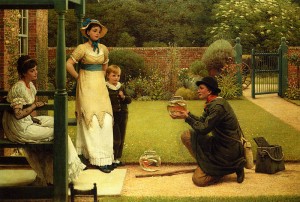 My cousin’s garden actually looks a bit similar to the one in this painting, The Goldfish Seller, by English painter Leslie George Dunlop (1835-1921). Of course, her house was a typical California ranch style, not a vine-covered brick cottage.
My cousin’s garden actually looks a bit similar to the one in this painting, The Goldfish Seller, by English painter Leslie George Dunlop (1835-1921). Of course, her house was a typical California ranch style, not a vine-covered brick cottage.

